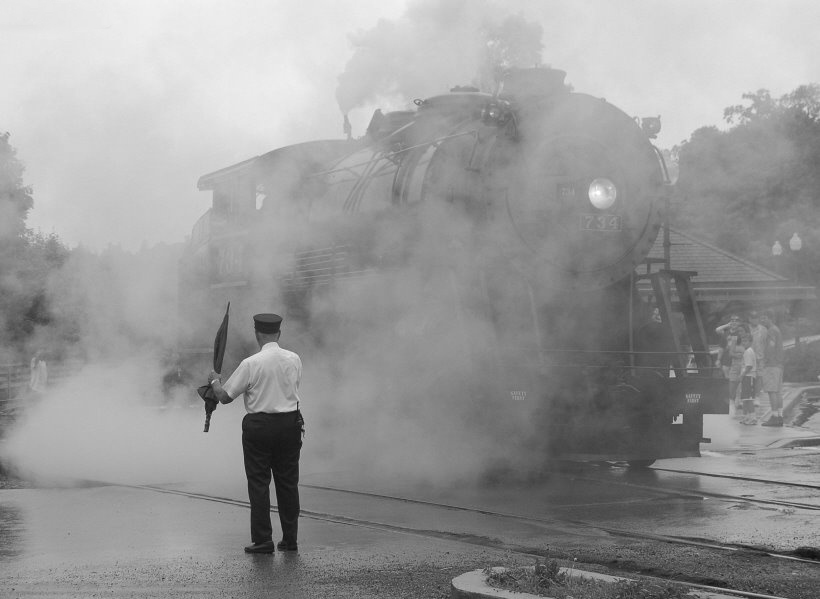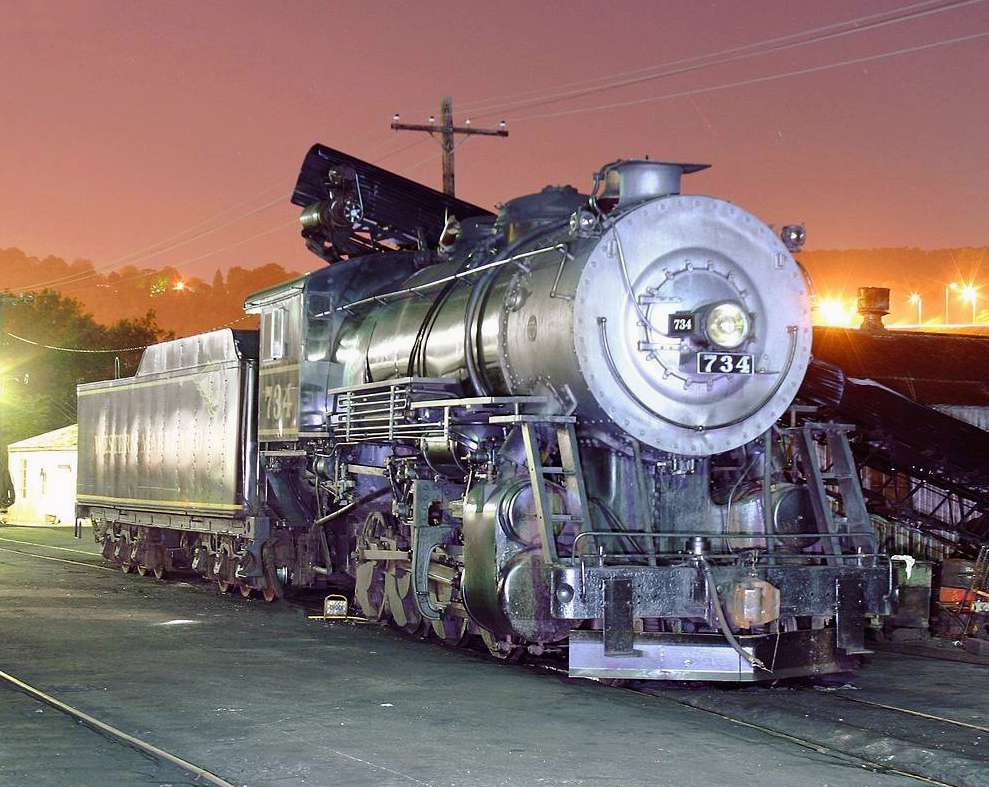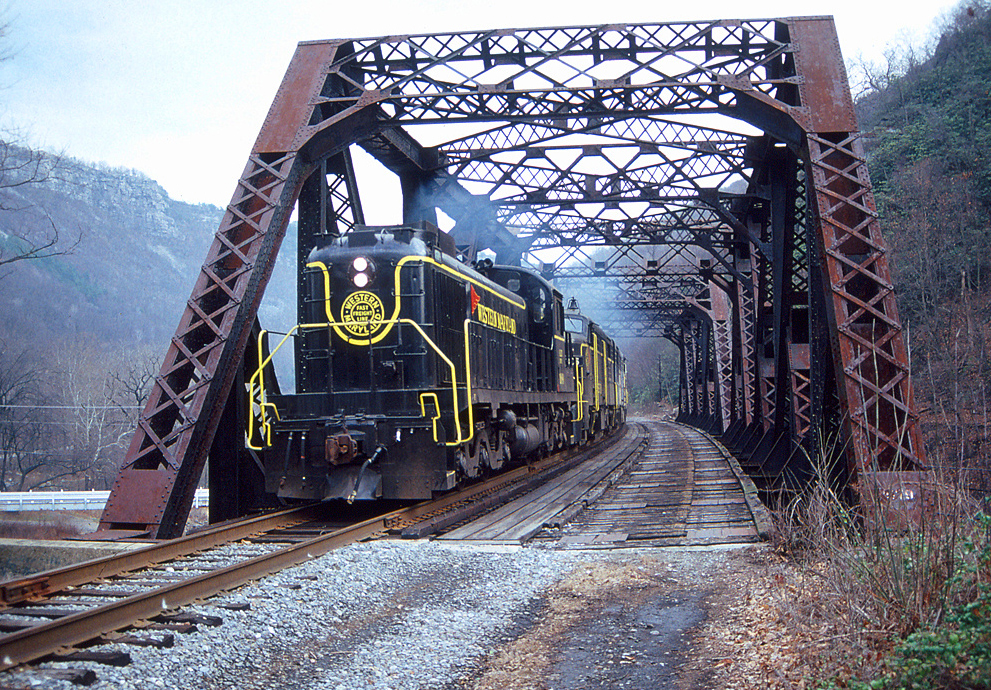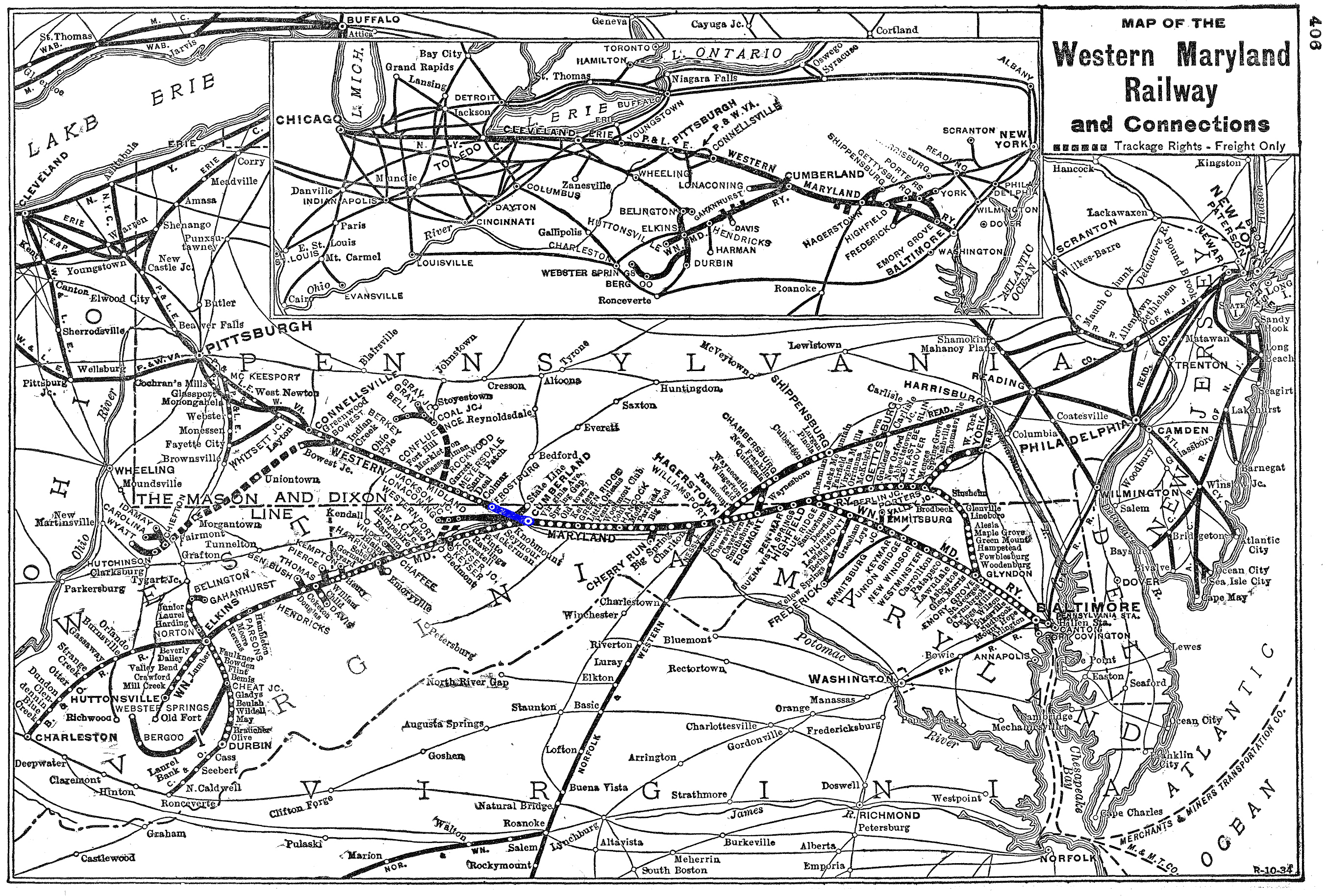Western Maryland Scenic Railroad: Preserving The WM's Legacy
Last revised: September 11, 2024
By: Adam Burns
The Western Maryland Scenic Railroad is an excursion based in
Cumberland, Maryland operating part of former Western Maryland
Railway’s "Connellsville Extension" which once linked the city with Connellsville, Pennsylvania.
Today, the WMSR maintains nearly 17 miles of the former WM corridor to Frostburg. This segment includes several scenic locations which includes "The Narrows" just west of Cumberland, 914-foot Brush Tunnel, and finally famous "Helmstetter's Curve."
Today, the railroad operates diesel-powered trains as well as recently restored Chesapeake & Ohio 2-6-6-2 #1309. WMSR remains one of the state's top tourism destinations enjoying up to 40,000 riders annually.
The railroad offers its guests a wide range of services, including on-board dining and alcohol/wine tasting trains. They also completed restoration of the big 2-6-6-2 in November, 2021.
Lastly, in January, 2024 the railroad announced it had leased a former Western Maryland line between Luke/Westernport and Midland, Maryland. The property will be known as the WMSR's Georges Creek Division and will eventually host excursions, as well as providing needed freight service.
 Western Maryland Scenic 2-8-0 #734 lets off steam while sitting at the station in Frostburg, Maryland on August 5, 2007 as the conductor looks on. Wade Massie photo.
Western Maryland Scenic 2-8-0 #734 lets off steam while sitting at the station in Frostburg, Maryland on August 5, 2007 as the conductor looks on. Wade Massie photo.History
Western Maryland Scenic's current route was once part of the Western Maryland's original main line connecting Cumberland with Connellsville, Pennsylvania where the company had friendly connections with other railroads like the Pittsburgh & West Virginia.
The two were part of the so-called "Alphabet Route", a consortium of railroads which offered high-speed service between between the Northeast and Midwest in competition against the three major trunk lines (Baltimore & Ohio, Pennsylvania, and New York Central Central).
These systems included:
- Nickel Plate Road
- Wheeling & Lake Erie
- Reading
- Central Railroad of New Jersey
- Lehigh & Hudson River
- New York, New Haven & Hartford
The Western Maryland's heritage began as the Baltimore, Carroll & Frederick Rail Road Company chartered in 1852.
According to the book, "The Western Maryland Railway: Fireballs And Black Diamonds" by Roger Cook and Karl Zimmermann, the road's promoters initially planned it to link Baltimore with the Monocacy River near then-Virginia's northeastern border (today, West Virginia's Eastern Panhandle).
It was renamed as the Western Maryland Rail Road Company in 1853 and by 1872 had opened to Hagerstown.
On May 7, 1902 George Gould's Fuller Syndicate acquired the Western Maryland from the city of Baltimore.
At the time, the WM was only a regional operation linking Baltimore with a B&O connection at Cherry Run, West Virginia (located just across the Potomac River from Maryland it was about 25 miles west of Hagerstown).
There were also secondary lines reaching Gettysburg and Shippensburg, Pennsylvania. For Gould, his plans involved utilizing the WM as the eastern component of his planned transcontinental railroad, a dream long-held by his late father, Jay (the notorious tycoon).
At the time he already controlled the Western Pacific, Rio Grande Western/Denver & Rio Grande, Missouri Pacific, Wabash Railroad, Wheeling & Lake Erie, and Wabash-Pittsburgh Terminal Railway.
As part of this endeavor he would push the WM westward to a connection with another of his properties near Pittsburgh, Pennsylvania.
The railroad reached Cumberland in 1906 but, while still under construction, Gould overextended his financial resources and the Western Maryland Rail Road entered bankruptcy on March 6, 1908.
It was reorganized as the Western Maryland Railway on December 1, 1909 and the 86-mile Connellsville Extension was completed on August 1, 1912.
Route
Its completion opened a western connection with the Pittsburgh & Lake Erie although its most important interchange here took place when the Pittsburgh & West Virginia finally completed its eastern link to Connellsville in the spring of 1931.
Soon afterward the "Alphabet Route" was launched. The Connellsville Extension opened the shortest rail route from Pittsburgh to Baltimore, featuring even lower grades than the Baltimore & Ohio's.
The line had been built under two subsidiaries; 18 miles of double track from Georges Creek Junction to Colmar (near the Maryland-Pennsylvania state line) were constructed as the Georges Creek & Cumberland Railroad Company.
The remaining 68 miles were built as the Connellsville & State Line Railway. In May, 1944, the WM acquired the Cumberland & Pennsylvania Railway, a system which closely paralleled its main line between Cumberland and Frostburg.
It ran as far south as Westernport where it reconnected with the WM and B&O. The C&P was primarily built as a coal hauler with a heritage dating back to 1850 and had once been managed by the WM during World War I (1917-1920).
In 1927 the WM had largely abandoned segments of the Georges Creek & Cumberland in favor of the C&P, the former of which was only used to serve various coal mines.
The Connellsville Extension remained WM's most important corridor throughout the railroad's corporate existence where high-speed freights operated to either Baltimore or the Reading connection at Shippensburg.
During the steam era big 4-6-6-4 "Challengers" operated west of Cumberland while the tried-and-true 2-10-0 Decapods also found regular assignments within this territory.
During the diesel era, Electro-Motive power was common such as F7's, GP35's, and SD40's.
The WM, as a truly independent carrier, ended in 1964 when the Chesapeake & Ohio and B&O jointly applied to acquire the railroad, a move granted by the Interstate Commerce Commission (ICC).
Under this setup the Western Maryland Railway continued to operate mostly independent until the 1972 formation of Chessie System, Inc. The new holding company controlled all three roads and, after its creation, began abandoning large sections of the WM.
 Western Maryland Scenic 2-8-0 #734 rests overnight at the yard in Ridgeley, West Virginia on August 31, 2004. Wade Massie photo.
Western Maryland Scenic 2-8-0 #734 rests overnight at the yard in Ridgeley, West Virginia on August 31, 2004. Wade Massie photo.This included the Connellsville Extension which the railroad petitioned for abandonment as of June 11, 1973.
Specifically it asked to remove 125 miles between Hancock, Maryland and Connellsville, Pennsylvania, except for a segment between Cumberland and Frostburg.
This nearly 17-mile section remained through the CSX Transportation era until the city of Cumberland eyed it as a possible tourist attraction.
What resulted was a joint effort; Allegany County ponied up $585,000, the city $2,470,560, and the city of Frostburg $338,427 to purchase the corridor.
As part of the deal the new Western Maryland Scenic Railroad was given the old WM shops in Ridgeley, West Virginia (across the Potomac River from downtown Cumberland).
Part of this money also went into the restoration of WM's grand station in Cumberland while a private individual meticulously restored the 1891, Cumberland & Pennsylvania wooden depot in Frostburg.
The Cumberland facility was originally completed in 1913 it is now home to the Western Maryland Station Center, Alleghany County Visitors Bureau, and C&O Canal National Historic Park Visitors Center.
In 1995, the state of Maryland acquired everything for $2.06 million.
Current Operations
One of the notable features of the WMSR's operations is Western Maryland's famed Helmstetter's Curve, which is located just west of Cumberland.
This photogenic location features a long, sweeping curve as it bends around a local farm whose barn is the centerpiece (a new structure replaced an older one in 2009 after it burned).
In 1991 steam arrived at the Western Maryland Scenic Railroad when it acquired a former Lake Superior & Ishpeming 2-8-0 from the Illinois Railway Museum.
A year later the railroad had the steamer in service and repainted it into Western Maryland colors.
Chesapeake & Ohio 2-6-6-2 #1309
Following more than seven years of work, that spanned 2014-2021, Chesapeake & Ohio 2-6-6-2 #1309 moved under its own power on December 31, 2020 for the first time in over 64 years. The locomotive's restoration was officially completed on November 19, 2021.
Today the big Mallet is the largest in operation east of the Mississippi River and has greatly enhanced the railroad's presence as a tourist attraction.
The railroad’s standard excursion takes you on a 4 ½ hour journey from Cumberland to Frostburg (where the locomotive’s are turned on the WM’s original turntable located in the town) and back again with a 1 ½ hour layover in the town.
Steam Roster (All-Time)
| Road Number | Arrangement | Builder | Date Built/Notes |
|---|---|---|---|
| 734 | 2-8-0 | Baldwin | April, 1916/Lake Superior & Ishpeming #34* |
| 1309 | 2-6-6-2 | Baldwin | 1949/Chesapeake & Ohio #1309 (H-6) |
* This locomotive appears as one of Western Maryland's trusty Class H-7 Consolidations. These workhorse 2-8-0's could be found all over WM's system. To further add to this appearance #734 sports the tender of New York Central 4-8-2 "Mohawk" #2662.
Diesel Roster (All-Time)
| Road Number | Model | Builder | Date Built/Notes |
|---|---|---|---|
| 41 | T-6 | Alco | 8/1959, Norfolk & Western #41 |
| 199 | RS-3 | Alco | 5/1954, Boston & Maine #1508 |
| 305 | FPA-4 | MLW | 1/1959, Canadian National #6771 |
| 501 | GP30 | EMD | 5/1963, Pennsylvania #2249 |
| 502 | GP30 | EMD | 4/1962, Reading #5507 |
| 1689 | RSD-5 | Alco | 9/1954, Chicago & North Western #1689 |
 An RSD5 and other Alco power lead a WMSR excursion through the Narrows near Cumberland, Maryland on December 7, 1991. Wade Massie photo.
An RSD5 and other Alco power lead a WMSR excursion through the Narrows near Cumberland, Maryland on December 7, 1991. Wade Massie photo.Aside from the WMSR's standard excursion they also operate specials like murder mystery trains (which includes a full on-board meal) and special holiday runs.
Other neat features include cab rides, caboose rentals, and even the Allegheny Highlands Trail for hiking and biking (this trail utilizes the former Connellsville Extension).
All in all, the Western Maryland Scenic operates through some of the most beautiful parts of the Appalachian Mountains and if you’re ever in the western Maryland region or Cumberland I would strongly suggest a visit to the railroad.
Lastly, if you have the time please consider volunteering to help them with not only restoration work but also maintaining their railroad.
To learn more about the Western Maryland Scenic Railroad please click here to visit their website.
There you will find everything you need to know about planning a trip to the railroad as they offer complete information regarding everything available, excursion schedules, special event dates, nearby dining and lodging, and much more.
Recent Articles
-
Kansas ~ Murder Mystery ~ Dinner Train Rides
Jan 21, 26 01:40 PM
Kansas, known for its sprawling wheat fields and rich history, hides a unique gem that promises both intrigue and culinary delight—murder mystery dinner trains. -
Florida ~ Murder Mystery ~ Dinner Train Rides
Jan 21, 26 01:05 PM
Florida, known for its vibrant culture, dazzling beaches, and thrilling theme parks, also offers a unique blend of mystery and fine dining aboard its murder mystery dinner trains. -
New Hampshire ~ Murder Mystery ~ Dinner Train Rides
Jan 21, 26 12:07 PM
The state's murder mystery trains stand out as a captivating blend of theatrical drama, exquisite dining, and scenic rail travel. -
New Jersey Dinner Train Rides In Woodstown
Jan 21, 26 11:20 AM
For visitors who love experiences (not just attractions), Woodstown Central’s dinner-and-dining style trains have become a signature offering—especially for couples’ nights out, small friend groups, a… -
Montana's Dinner Train Rides Near Lewistown!
Jan 21, 26 10:40 AM
The Charlie Russell Chew Choo turns an ordinary rail trip into an evening event: scenery, storytelling, live entertainment, and a hearty dinner served as the train rumbles across trestles and into a t… -
Kansas Valentine's Train Rides
Jan 21, 26 10:09 AM
While the railroad’s regular-season excursions are a big draw, the A&SV also shines with its calendar of themed trains—none more romantic than its Valentine’s Day special. -
Alabama Valentine's Train Rides
Jan 21, 26 09:39 AM
The Heart of Dixie Railroad Museum (HoDRM) is the kind of place where history isn’t parked behind ropes—it moves. This includes Valentine's Day weekend, where the museum hosts a wine pairing special. -
Wisconsin's Dinner Train Rides In North Freedom!
Jan 20, 26 01:55 PM
Featured here is a practical guide to Mid-Continent’s dining train concept—what the experience is like, the kinds of menus the museum has offered, and what to expect when you book. -
New York's Dinner Train Rides In The Adirondacks!
Jan 20, 26 12:41 PM
Operating over a restored segment of the former New York Central’s Adirondack Division, the Adirondack Railroad has steadily rebuilt both track and public interest in passenger rail across the region. -
Pennsylvania "Dinner Train" Rides In Boyertown!
Jan 20, 26 12:04 PM
With beautifully restored vintage equipment, carefully curated menus, and theatrical storytelling woven into each trip, the Colebrookdale Railroad offers far more than a simple meal on rails. -
New York ~ Murder Mystery ~ Dinner Train Rides
Jan 20, 26 12:03 PM
New York State, renowned for its vibrant cities and verdant countryside, offers a plethora of activities for locals and tourists alike, including murder mystery train rides! -
Pennsylvania ~ Murder Mystery ~ Dinner Train Rides
Jan 20, 26 11:48 AM
Pennsylvania, steeped in history and industrial heritage, offers a prime setting for a unique blend of dining and drama: the murder mystery dinner train ride. -
Florida Valentine's Train Rides
Jan 20, 26 11:46 AM
For couples looking for something different this Valentine’s Day, the museum’s signature romantic event is back: the Valentine Limited, returning February 14, 2026—a festive evening built around a tra… -
Connecticut Valentine's Train Rides
Jan 20, 26 11:43 AM
Operated by the Valley Railroad Company, the attraction has been welcoming visitors to the lower Connecticut River Valley for decades, preserving the feel of classic rail travel while packaging it int… -
Texas Dinner Train Rides At The TSR!
Jan 19, 26 12:30 PM
Today, TSR markets itself as a round-trip, four-hour, 25-mile journey between Palestine and Rusk—an easy day trip (or date-night centerpiece) with just the right amount of history baked in. -
Iowa's Dinner Train Rides In Boone!
Jan 19, 26 12:28 PM
If you’ve ever wished you could pair a leisurely rail journey with a proper sit-down meal—white tablecloths, big windows, and countryside rolling by—the Boone & Scenic Valley Railroad & Museum… -
Ohio Dinner Train Rides At The CVSR!
Jan 19, 26 12:27 PM
While the railroad is well known for daytime sightseeing and seasonal events, one of its most memorable offerings is its evening dining program—an experience that blends vintage passenger-car ambience… -
Missouri's Dinner Train Rides In Branson!
Jan 19, 26 12:21 PM
Nestled in the heart of the Ozarks, the Branson Scenic Railway offers one of the most distinctive rail experiences in the Midwest—pairing classic passenger railroading with sweeping mountain scenery a… -
Virginia Valentine's Train Rides
Jan 19, 26 12:15 PM
If you’ve ever wanted to slow life down to the rhythm of jointed rail—coffee in hand, wide windows framing pastureland, forests, and mountain ridges—the Virginia Scenic Railway (VSR) is built for exac… -
Maryland Valentine's Train Rides
Jan 19, 26 12:12 PM
The Western Maryland Scenic Railroad (WMSR) delivers one of the East’s most “complete” heritage-rail experiences: and also offer their popular dinner train during the Valentine's Day weekend. -
Indiana's Dinner Train Rides In Jasper!
Jan 18, 26 01:54 PM
In the rolling hills of southern Indiana, the Spirit of Jasper offers one of those rare attractions that feels equal parts throwback and treat-yourself night out: a classic excursion train paired with… -
New Mexico's Dinner Train Rides
Jan 18, 26 01:37 PM
If your heart is set on clinking glasses while the desert glows at sunset, you can absolutely do that here—just know which operator offers what, and plan accordingly. -
New Hampshire ~ Murder Mystery ~ Dinner Train Rides
Jan 18, 26 01:10 PM
The state's murder mystery trains stand out as a captivating blend of theatrical drama, exquisite dining, and scenic rail travel. -
New York Valentine's Train Rides
Jan 18, 26 12:32 PM
At its best, the Adirondack Railroad delivers exactly what railfans and casual riders alike hope for: vintage coaches, classic depots, rivers and forests right outside the window. -
Washington Valentine's Train Rides
Jan 18, 26 10:50 AM
Whether you’re a dedicated railfan chasing preserved equipment or a couple looking for a memorable night out, CCR&M offers a “small railroad, big experience” vibe—one that shines brightest on its spec… -
Colorado Valentine's Train Rides
Jan 18, 26 10:49 AM
The Royal Gorge Route Railroad is the kind of trip that feels tailor-made for railfans and casual travelers alike, including during Valentine's weekend. -
Georgia Valentine's Train Rides
Jan 18, 26 10:42 AM
f you’ve ridden the SAM Shortline, it’s easy to think of it purely as a modern-day pleasure train—vintage cars, wide South Georgia skies, and a relaxed pace that feels worlds away from interstates and… -
New Jersey ~ Murder Mystery ~ Dinner Train Rides
Jan 17, 26 01:16 PM
There are currently no murder mystery dinner trains available in New Jersey although until 2023 the Cape May Seashore Lines offered this event. Perhaps they will again soon! -
West Virginia Dinner Train Rides In Elkins!
Jan 17, 26 01:08 PM
The D&GV offers the kind of rail experience that feels purpose-built for railfans and casual travelers. -
Virginia Dinner Train Rides In Staunton!
Jan 17, 26 11:55 AM
If you’ve ever wished you could pair a classic scenic train ride with a genuinely satisfying meal—served at your table while the countryside rolls by—the Virginia Scenic Railway was built for you. -
Florida Easter Train Rides
Jan 17, 26 10:23 AM
The cold weather rarely invades Florida and the state nearly always warm and balmy early spring temperatures. Learn more about where you can find Easter-themed train rides across the Sunshine State. -
Ohio Easter Train Rides
Jan 17, 26 10:13 AM
Ohio is home to several museums and excursion trains preserving the state's rich railroading heritage. A few of these locations host Easter-themed train rides each spring. -
Massachusetts Valentine's Train Rides
Jan 17, 26 09:58 AM
The Cape Cod Central Railroad (CCCR) blends classic New England scenery with heritage equipment, narrated sightseeing, and some of the region’s best-known “rails-and-meals” experiences. -
California Valentine's Train Rides
Jan 17, 26 09:53 AM
Operating out of West Sacramento, this excursion railroad has built a calendar that blends scenery with experiences—wine pours, themed parties, dinner-and-entertainment outings, and seasonal specials… -
South Carolina Dinner Train Rides
Jan 16, 26 11:13 PM
There is only location in the Palmetto State offering a true dinner train experience can be found at the South Carolina Railroad Museum. Learn more here. -
Rhode Island Dinner Train Rides
Jan 16, 26 11:01 PM
Despite its small size, Rhode Island is home to one popular dinner train experience where guests can enjoy the breathtaking views of Aquidneck Island. -
Pennsylvania's Thomas The Train Rides
Jan 16, 26 04:13 PM
"A Day Out With Thomas” train rides offer a unique opportunity for children and their families to engage in a magical and memorable experience, setting the stage for a full day of fun and adventure. -
Illinois's Thomas The Train Rides
Jan 16, 26 02:23 PM
In Illinois, the "A Day Out With Thomas" event offers a unique chance for families to immerse themselves in the enchanting world of Thomas and friends, creating memories that last a lifetime. -
New Jersey's Thomas The Train Rides
Jan 16, 26 02:11 PM
Here's a comprehensive guide to what you can expect at Day Out With Thomas events in New Jersey. -
Texas ~ Murder Mystery ~ Dinner Train Rides
Jan 16, 26 01:54 PM
Here’s a comprehensive look into the world of murder mystery dinner trains in Texas. -
Connecticut ~ Murder Mystery ~ Dinner Train Rides
Jan 16, 26 01:26 PM
All aboard the intrigue express! One location in Connecticut typically offers a unique and thrilling experience for both locals and visitors alike, murder mystery trains. -
New Hampshire Dinner Train Rides In N. Conway!
Jan 16, 26 10:47 AM
Tucked into the heart of New Hampshire’s Mount Washington Valley, the Conway Scenic Railroad is one of New England’s most beloved heritage railways -
Oregon Dinner Train Rides Near Mt. Hood!
Jan 16, 26 10:44 AM
The Mt. Hood Railroad is the moving part of that postcard—a century-old short line that began as a working railroad. -
Maryland's - Wine Tasting - Train Rides
Jan 15, 26 02:59 PM
This article delves into the enchanting world of wine tasting train experiences in Maryland, providing a detailed exploration of their offerings, history, and allure. -
Colorado's - Wine Tasting - Train Rides
Jan 15, 26 02:46 PM
To truly savor these local flavors while soaking in the scenic beauty of Colorado, the concept of wine tasting trains has emerged, offering both locals and tourists a luxurious and immersive indulgenc… -
Iowa ~ Wine Tasting ~ Train Rides
Jan 15, 26 02:36 PM
The state not only boasts a burgeoning wine industry but also offers unique experiences such as wine by rail aboard the Boone & Scenic Valley Railroad. -
Georgia's Wine Train Rides In Cordele!
Jan 15, 26 02:26 PM
While the railroad offers a range of themed trips throughout the year, one of its most crowd-pleasing special events is the Wine & Cheese Train—a short, scenic round trip designed to feel like a t… -
Indiana ~ Murder Mystery ~ Dinner Train Rides
Jan 15, 26 02:22 PM
This piece explores the allure of murder mystery trains and why they are becoming a must-try experience for enthusiasts and casual travelers alike. -
Ohio ~ Murder Mystery ~ Dinner Train Rides
Jan 15, 26 02:10 PM
The murder mystery dinner train rides in Ohio provide an immersive experience that combines fine dining, an engaging narrative, and the beauty of Ohio's landscapes. -
Nevada Dinner Train Rides In Ely!
Jan 15, 26 02:01 PM
If you’ve ever wished you could step through a time portal into the hard-working world of a 1900s short line the Nevada Northern Railway in Ely is about as close as it gets.
















































